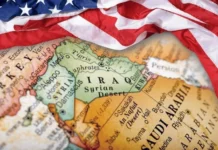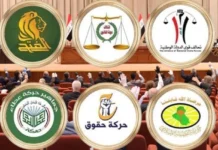The Dinar Is Recovering. Four Painful Blows To The Parallel Dollar Reveal The Successes Of The Iraqi Economic Program.
July 26, 2025 Baghdad / Iraq Observer
The US dollar in Iraq is witnessing significant and sustained decline against the national dinar, following a significant period of fluctuation far from the official exchange rate. This was not arbitrary, but rather the result of a comprehensive economic policy pursued by the Iraqi government as part of a reform vision it envisioned within its program. Amid escalating debate over the stability of the Iraqi market and the varying indicators associated with the dollar exchange rate, the Prime Minister’s financial advisor, Mazhar Mohammed Salih, issued detailed statements revealing the reasons for the continued decline in the value of the dollar on the parallel market, compared to a significant rise in the strength of the Iraqi dinar.
He also emphasized that this shift was not a coincidence, but rather the direct result of a series of coordinated government measures across monetary, fiscal, and trade policies implemented over the past two years.
*4 main reasons
Saleh attributed the decline in the dollar exchange rate on the parallel market,
which is now approaching the official rate, to four main reasons. Speaking to Iraq Observer, he said,
“The first factor is the strict legal ban on dollar trading in domestic transactions, particularly in the real estate market, which is one of the largest and strongest financial markets in the country.
This has reduced the scope for informal foreign currency trading.” He added that the second reason relates to “the shift in monetary policy toward direct foreign exchange support via international banks that correspond with national banks for external transfer purposes,
in contrast to the discontinuation of the Central Bank’s currency selling window at the beginning of this year.” He noted that “this policy has limited reliance on the parallel market and the risks of unsafe and high-cost financing.”
Observers describe this step as “not just a technical choice,
but rather a comprehensive strategy to connect Iraqi banks to the international financial system without the need for dubious or unclearly compliant local channels.
Thus, the map of foreign transfers was redrawn to be conducted legally and regulated, gradually reducing the influence of the parallel market and currency exchange companies, which had previously acted as intermediaries between importers and exporters and set prices as they pleased.”
* Liberalization of small importers
The third reason, according to the government advisor, relates to “small importers’ access to the official foreign currency financing network without the need for intermediaries from money transfer companies.
This has enabled them to import at a fixed, official exchange rate and has contributed to reducing costs and enhancing compliance, especially since this segment represents approximately 60% of the volume of foreign trade.”
He emphasized that “this facilitation came about thanks to government measures that reduced administrative bureaucracy.” With this opening, exchange rates for these traders became fixed at the official rate (1,320 dinars to the dollar), which caused the parallel market to lose a large segment of its customers, who had been the primary fuel for the increased demand for dollars outside of official channels.
He pointed out that the * Payment cards… another reason
fourth factor is the “expansion of the culture of using foreign currency electronic payment cards among travelers over the past two years, rather than putting pressure on the cash dollar market, in addition to the availability of cash dollars to travelers at airports through national banks, subject to flexible and highly compliant regulatory controls.”
In the past, travelers preferred to carry large amounts of dollars in cash, creating additional demand for hard currency in the local market, especially during travel, tourism, or study seasons.
Consequently, the switch to bank cards has contributed to market stability and reduced speculation. Saleh concluded his remarks by emphasizing that “the price defense policy adopted by the state, through the establishment of cooperatives for consumer goods and the construction basket funded at the official exchange rate of 1,320 dinars to the dollar, represents an integral part of the success of economic policy in Iraq, through the harmonization of monetary, financial, and commercial efforts within the government program.”
With the continued flow of dollars into official channels, the expansion of financial oversight tools, and the promotion of a culture of electronic payments, the Iraqi dinar is now gradually approaching the rate officially set by the Central Bank of Iraq.
* Government efforts…the decisive role
For his part, economic expert Safwan Qusay says that the dinar’s appreciation against the dollar comes against the backdrop of the Central Bank of Iraq‘s reserves rising to more than $97 billion, in addition to gold reserves exceeding 132 tons.
This boosts confidence in the Iraqi economy and provides significant support to the value of the local currency. In an interview with Iraq Observer, the economic expert emphasized the positive outlook for increasing non-oil revenues and the government’s ongoing efforts to halt gas flaring and develop energy and development projects.
He noted that adjusting the public spending structure toward sustainability plays a crucial role in achieving economic and financial stability.
According to Qusay, maintaining and developing positive relations with the United States and the Gulf states could significantly boost the value of the Iraqi dinar,
especially following US President Donald Trump’s speech encouraging support for US exports to Iraq.
Qusay emphasized that the exit of Syria and Lebanon from the risk zone directly contributed to supporting financial stability in Iraq, which positively impacted the dinar exchange rate. https://observeriraq.net/الدينار-يستعيد-عافيته-أربع-ضربات-موجع/
Secret Meeting In Istanbul: Washington Threatens New Financial Sanctions On Iraq
July 25, 2025 Last updated: July 25, 2025 Al-Mustaqilla/- An informed source revealed to Al-Mustaqilla that an unannounced meeting was held in Istanbul in recent days, bringing together the Assistant Chairman of the US Federal Reserve and a high-ranking delegation from the Central Bank of Iraq.
The source stated that the meeting came at the urgent invitation of the US to discuss critical developments in the file of financial transfers and Iraqi banking transactions. According to the source,
the US side informed the Iraqi delegation that new financial sanctions are under preparation, to be imposed on a number of Iraqi banks and financial institutions, due to what the US side described as “continued violations” in international transfer systems and the failure of some Iraqi entities to comply with international guidelines to combat money laundering and terrorist financing.
The source indicated that Direct warnings
the Iraqi delegation received direct warnings of the possibility of freezing additional assets and imposing restrictions on dollar accounts if urgent measures are not taken to regulate the Iraqi financial system and prevent suspicious flows through some Iraqi banks and companies.
A new crisis is looming
These developments come amid escalating tensions between Baghdad and Washington over economic and security issues, most notably restrictions on dollar transfers and US accusations against some Iraqi entities of dealing with entities on sanctions lists.
Observers believe that the new sanctions, if implemented, will deal a severe blow to the Iraqi banking system and could lead to a further deterioration in the value of the dinar and increased pressure on the local market at a time when the Central Bank of Iraq is trying to revive investor confidence and stabilize the exchange rate.
No official comment yet
As of the time of writing this report, no official comment has been issued by the Central Bank of Iraq or the US Embassy in Baghdad regarding the content of the meeting or the content of the warnings contained therein. https://mustaqila.com/اجتماع-سري-في-إسطنبول-واشنطن-تهدد-بعقو/
Monetary Policy, Monetary Stability Approach, And Digital Transformation 2023-2025
Economic 07/27/2025 Baghdad: Morning Among the new economic publications, the book
“Monetary Policy in Iraq, Monetary Stability Methodology, and Digital Transformation 2023-2025”
was released by financial expert Samir Al-Nusairi.
This book addresses several economic and monetary themes, reflecting the Central Bank of Iraq‘s orientations and its financial and banking reform policies in recent years, specifically for the period 2021-2026, with a strategic outlook extending to 2025.
Chapter One: The Central Bank and Opportunities
monetary stability
The author sheds light on the methodology of monetary policy, discussing the functions and objectives of the Central Bank of Iraq, the challenges facing monetary policy, and presenting the steps towards monetary stability and the pillars of monetary policy for the period 2021–2023.
Chapter Two: Digital Transformation and Financial Inclusion
The chapter reviews the Central Bank‘s efforts in digital transformation, developing electronic payments, and supporting financial inclusion, in addition to developing payment and systems government support for information technology and cybersecurity.
Chapter Three: The Central Bank’s Strategy for Financial and Banking Reform 2024-2025
This chapter covers the strategic objectives of the reform, the Bank‘s vision for 2025, the activation of economic measures, the regulation and financing of trade, and the management of economic challenges and variables.
Chapter Four: Government Support for Achievement
banking reform
The importance of cooperation between government agencies and the Central Bank is highlighted,
with discussions on the comprehensive banking reform project, the role of the private banking sector, the International Monetary Fund, and the vision for reform in Iraq.
Chapter Five: Exchange Rates and Recovery Procedures
It addresses the causes of exchange rate fluctuations, the factors affecting stability, particularly the difference between the official and parallel rates, and the government’s role in stimulating the private banking sector. https://alsabaah.iq/118049-.htm





